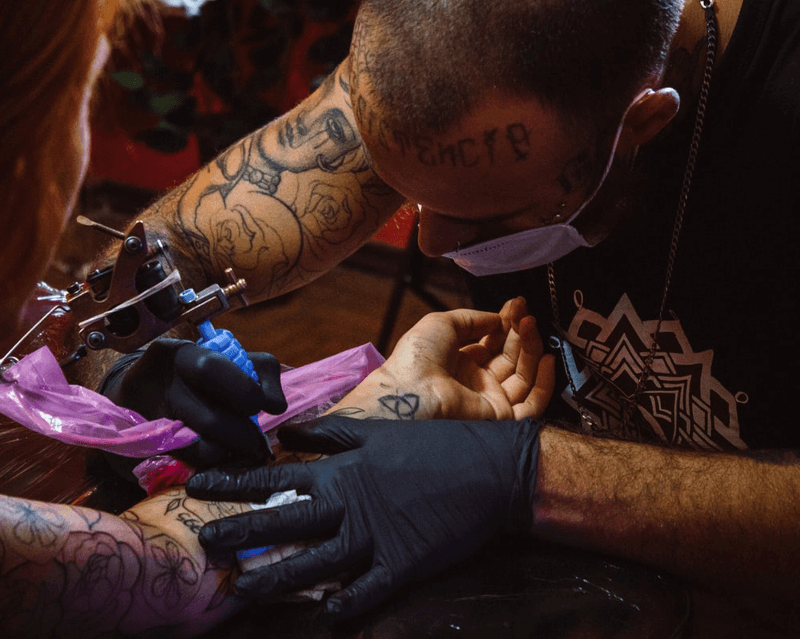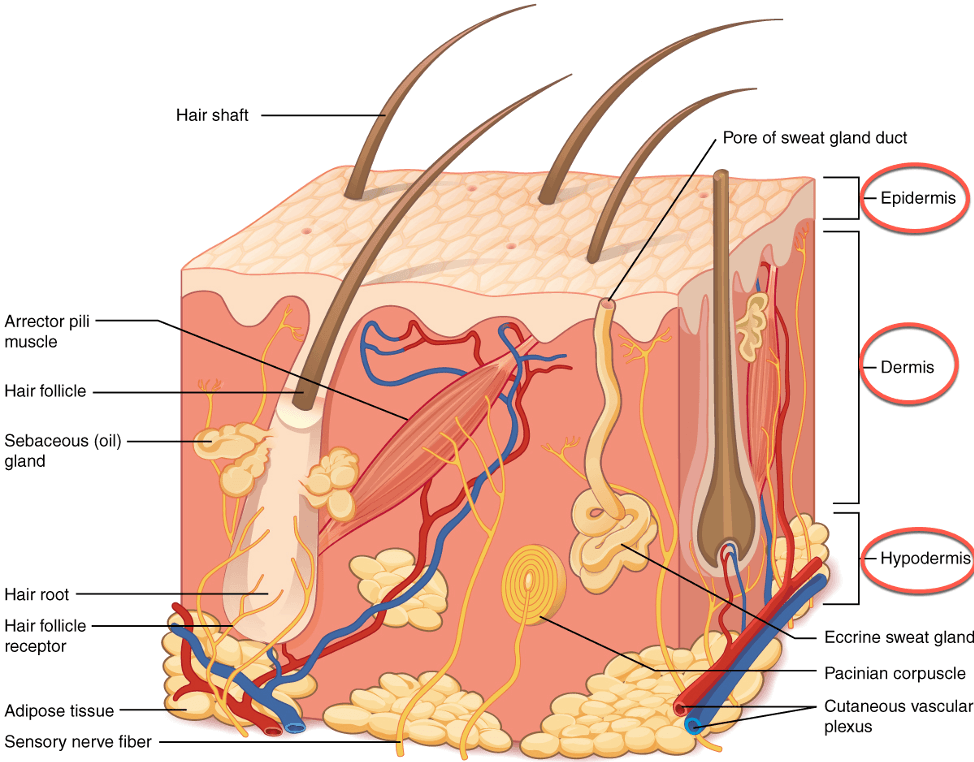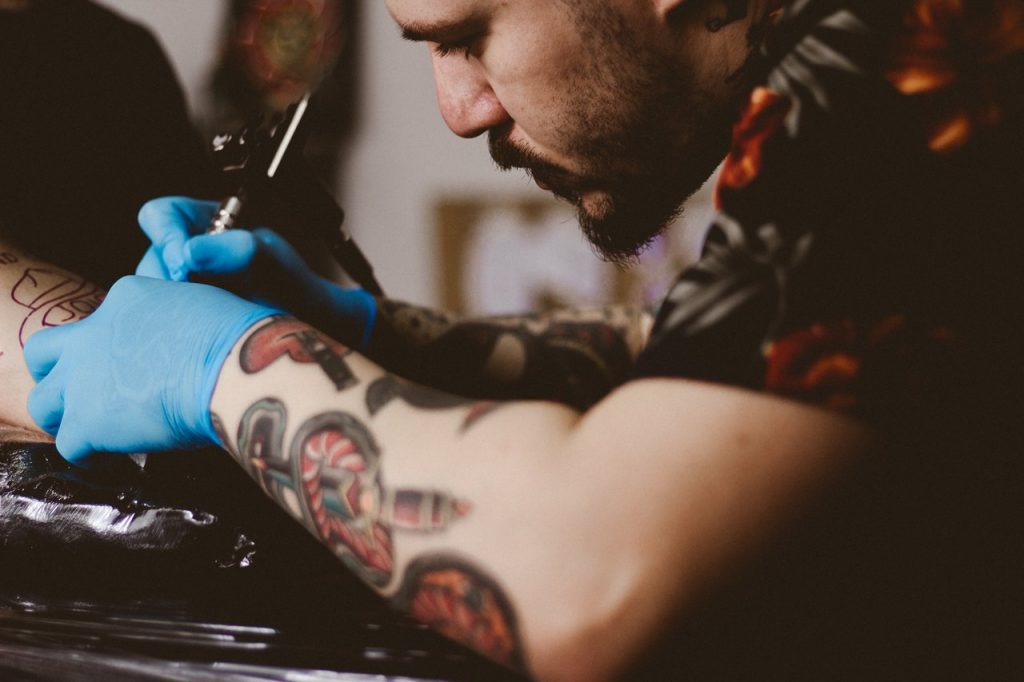Wondering how tattoos work and why ink stays in skin for decades? If you’re a newbie to the tattooing world, this article is a must-read! We cover all the basic things everyone should know about tattoos, so you can decide if getting inked is the right choice for you.
Page Contents
How to do a permanent tattoo?
Obviously, I’m not talking about peel ‘n stick tattoos, henna tattoos, airbrush tattoos, the so-called ‘sunburn’ tattoos, and other similar temporary “tattoos.” Permanent tattoos refer to skin art that’s done by sticking needles – often, lots of them! – in the skin.
Technically, you only need a needle and ink to make a permanent tattoo – this is what happens with DIY tattoos or stick and poke tattoos. This traditional way of doing tattoos is said to be more painful since one needle poke translates to just one dot on the skin.

A tattooist using a tattoo machine on a client (Photo by Antonino Visalli)
By contrast, modern tattooists use tattooing equipment such as coiled and rotary tattoo machines. These machines allow artists to use a cluster of tattoo needles to achieve different goals. Some needle groupings work great for tattooing small lines, thick lines and outlines on the skin. Other needles are more efficient for colour fillings and shading work.
What this all means is that tattooists can finish a large and complex tattoo in a relatively short period of time. This is because these machines can poke the skin hundreds or thousands of times a minute (no human can manually do this).
The tiny holes in the skin make it easy for tattoo ink to seep through to the skin’s inner layers. This is why it’s important to work with someone who knows how to do tattoos the right way.
An inexperienced tattooist can either puncture the skin too shallow or too deep – either won’t bode well for your tattoo. There’s really only one right way to do a permanent tattoo – and that is to deposit ink in the dermis layer of the skin.
If you’re asking how far tattoo needles need to go in your skin, well, that really depends on the area being worked on. Some body parts have more skin fat, while others are literally skin over bone. An artist who has prior experience in the same area will know exactly how deep the needle should go.
Related article: Tattoo Pain Chart: How Bad Do Tattoos Hurt?
How tattoos work: why are tattoos permanent?
Here’s a video showing why tattoos last so long on skin:
If you can’t play the video above, here’s what happens on the skin:
Tattoo ink is inserted in the dermis
Before we go further, I’d just like to say that I find it incredible that thousands of years ago, someone discovered (most likely by accident) that ink needs to be deposited at a certain depth so it can stay there permanently!
Now, as you can see in the image below, the human skin is made up of 3 layers:
- the epidermis (topmost layer)
- the dermis (middle layer)
- the hypodermis (bottom layer)

For tattoos to remain in the skin forever, the ink needs to be deposited in the dermis layer. This is because unlike the epidermis, the dermis does not shed or renew every 3-4 weeks.
Getting ink on the epidermis during the tattooing process is totally normal. However, you can expect it to disappear within a few weeks once the entire skin layer renews. This is the case with so-called “semi-permanent tattoos.” The ink gets absorbed in the epidermis but vanishes after a couple of weeks.
But what about the hypodermis, you ask?
Well, when ink gets into the hypodermis, it causes an effect called a ‘tattoo blowout.’ The ink underneath the skin spreads out and looks blurred. This is because the hypodermis is made up of blood vessels and lobules of fat cells, so it’s much harder for the ink to settle (unlike in the dermis). If you find your skin bleeding far more than usual, it’s highly likely the ink made its way into the hypodermis.
How does tattoo ink stay in the skin (or more specifically, the dermis)?
As soon as the tattoo needle punctures the skin and ink is deposited, the body’s immune system springs into action to try and repair the skin. It perceives the ink as a threat and sends macrophages to the area to try to contain it, so it can get rid of it.
Unfortunately for the macrophages (and fortunately for us tattoo lovers), the ink particles are way too big for them to absorb and destroy. So, they end up absorbing the ink and keeping them permanently in the dermis.
However, over time and with frequent sun exposure, the ink particles will get broken down into smaller particles. This allows the body to get rid of the pigment where it gets carried away by the bloodstream, into the lymph nodes, and eventually, gets eliminated as waste. This is why tattoos look faded as the years go by.
What is tattoo ink made from?
Now that you know how tattoos work, it’s time to know what’s in the ink used in most tattoos. You may be surprised to know that the tattoo ink industry isn’t regulated, so there’s a wide variety of ingredients used to make the ink.
That said, tattoo ink has two components: pigment and carrier. The pigment is basically the dye that gives colour to the tattoo. The carrier, on the other hand, is the liquid base that helps ‘transport’ the pigment from the needle to the skin.
Pigment
For pigments, the material used depends on the colour. To clue you in on how unsafe some tattoo ink ingredients are, here’s a partial list:
- Black ink – carbon, nickel, iron
- Red – mercury, cadmium
- Yellow – lead, cadmium, zinc
- Orange – cadmium
- Green – lead, chromium, aluminium, copper
As you can see, some of these ingredients are heavy metals! Sure, they’d add a nice colour to your tattoo, but don’t be surprised if you get a tattoo ink allergy. Also, some heavy metals can cause a reaction even on old tattoos. Cadmium, for instance, is photosensitive, so when it’s exposed to the sun, it can cause your tattoo to itch unbearably!
Carrier
Ink carriers play a huge role in ensuring the ink gets to the right spot. Distilled water can be used, yes, but many manufacturers (and artists who make/mix their own ink) prefer alcohol-based carriers. The alcohol prevents bacteria from growing in the liquid solution.
That said, some of the safer options out there include ethyl alcohol, glycerine, listerine, witch hazel and propylene glycol. Watch out – and stay away – from tattoo ink that uses denatured alcohol, methanol, rubbing alcohol, formaldehyde and antifreeze as carriers!
Fortunately, many ink manufacturers are now using more skin-friendly ingredients. Don’t be afraid to ask your tattooist about the ingredients used in their ink. You’ve got the right to know, it is your skin after all!
Related article: The Truth About Tattoo Ink: What Is Tattoo Ink Made Of?
What to look for in a tattoo artist?

Professional tattooists can charge a handsome price for their services. They spend years learning their craft. And it’s not a job for the faint-hearted. I mean, they are technically doing a minor medical operation and leaving a permanent mark on people’s skin. If they botch the job, it can come back to haunt them big-time.
Registered
Stay away from scratchers, a.k.a. unlicensed wannabe tattooists. You should only work with a registered tattooist. Their certificate or license should be displayed in their shop. If you can’t see it, then ask to see it. Better safe than sorry, mate.
Clean premises
Tattooing is a bloody business. You wouldn’t want to get blood and other organic matter from other people on you, right? That would be highly unsanitary and can lead to tattoo infection and various diseases!
Visit the studio prior to your appointment and take note of what’s going on inside:
- Does the tattooist put on fresh new gloves for every client?
- Do they use fresh, disposable needles for every appointment?
- Is the tattoo machine and its power supply wrapped in disposable plastic?
- What about the chair you’ll be sitting on? Is it wrapped in plastic as well?
You want to work with a tattooist who prioritises everyone’s safety. Bloodborne pathogens and viruses are no joke, as you’re probably aware of the recent coronavirus pandemic.
Experienced
If you want to get your money’s worth, then it’s best to work with someone who actually knows what they’re doing. If you’ve got a specific design in mind, you can look for a tattooist who specialises in your type of design.
If you don’t know anybody, don’t be afraid to ask for referrals. The tattoo community is relatively small and tight-knit, and referrals happen all the time. That said, if you don’t have a specific design yet, ask to see their portfolio so you get a few ideas. You can also ask if they have any pre-designed artworks available.
Final thoughts
Now that you know how tattoos work, go on out there and have fun! Keep in mind all the pointers you’ve learned in this article, and you’ll have a safe and hopefully enjoyable tattooing session.
